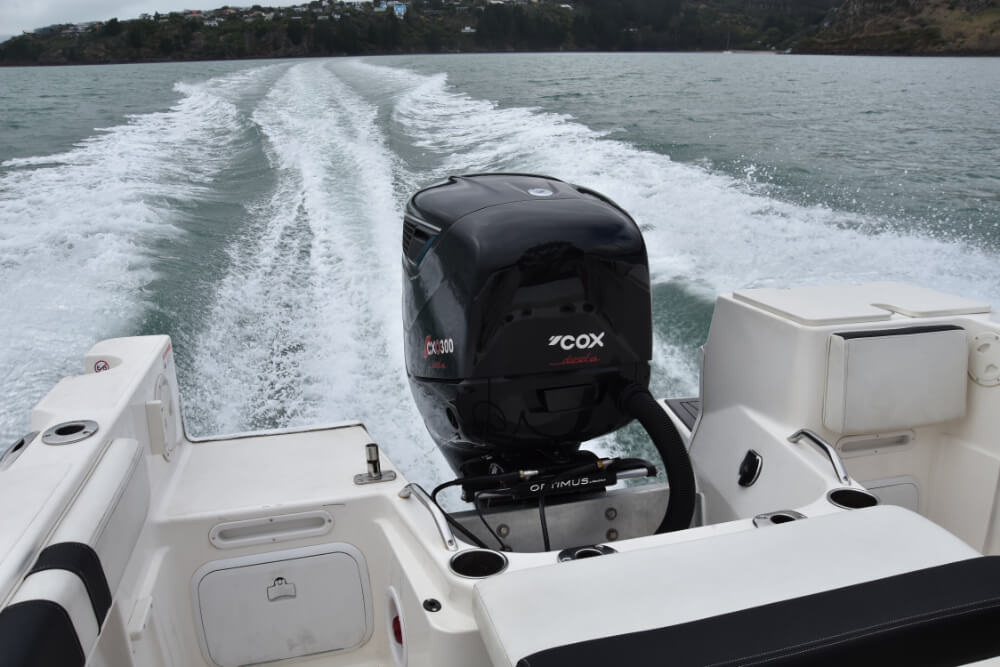The COX 300 diesel outboard has up to 30% better fuel efficiency compared to a 300hp petrol outboard.
Danny Casey offers some thoughts on what the outboard of the immediate and not-too-distant future may be like, and why “trickle-down” automotive technology may not always be the most logical step.
With the automotive industry currently racing towards a credible and viable alternative to the internal combustion engine (ICE) and zoning in rapidly, and maybe somewhat hastily and rashly, on an all-electric future, one would be tempted to think that the outboard industry – by virtue of the overlap and synergy with the land-transport sector enjoyed by three of the major manufacturers – would not be far behind in terms of opting for an electric or even hybrid solution, but that is possibly a rather simplistic supposition at present
The 2-Stroke: RIP or just resting?
Before examining what technology may be waiting in the wings, one can say – well, I will say emphatically – that it will not, under any circumstances, involve any reincarnation or revamped iteration of 2-stroke technology. Firstly, let me go on the record and state that I still love, and have always loved, 2-stroke outboards (2-stroke anything, actually – even early Saabs and Eastern European cars!) – it is hard to beat the feel of frenzied, frenetic urgency as the engine spools up, making one complete power cycle with one upward and one downward stroke of the piston (all done in only one crankshaft revolution). Then there is the intoxicating, heady, addictive concoction of oil, mixed with fuel, burning off through the morning dew and the dawn, or memories of the buzzy toing and froing in the seconds before flag-drop at a boat race, with an addictive and hedonistic blue, aromatic haze encroaching pungently yet sweetly on one’s nostrils. Forgive me – I was getting carried away with nostalgia from a halcyon era there…!
But, warm, fuzzy nostalgia aside, there is little reason to view the conventional 2-stroke outboard motor as anything other than noisy, smelly and inordinately thirsty. There have, of course, been progressive, innovative and much cleaner developments of 2-stroke technology, like the Orbital-derived Mercury Optimax and Tohatsu TLDI motors and other proprietary direct-injection systems like Yamaha’s HPDI, OMC’s Ficht/Ficht RAM and, latterly BRP’s E-Tec and G2 motors but, take it from me, this was dead-end engineering, solely to circumvent emission-level hurdles before the major manufacturers had to bite the bullet and go all-in to develop 4-strokes. This “advanced” 2-stroke technology has been consigned to history and is now a firmly closed book.
Modern boaters do not want, and will no longer accept, what is known as “total-loss lubrication”, where oil has to be added separately – regardless of how infrequently – to a remote reservoir (not a conventional “oil bath” sump). Nor do they want their olfactory senses and eyes assailed with the sharp, tangy, acrid smell of synthetic oil being burned off as part of the combustion process.
BRP has, of course, stuck resolutely with DI 2-stroke technology for its new Rotax (originally Project “Ghost”) marine propulsion unit (not a conventional, vertically-oriented outboard in the true sense),
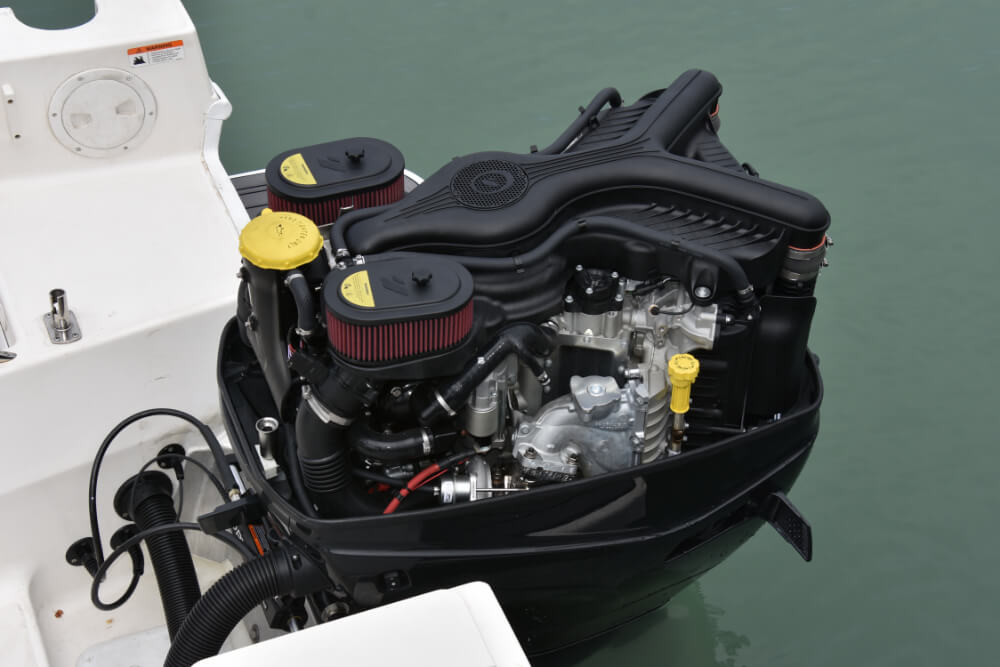
so it is conceivable that they have done exhaustive market research and therefore maybe know something the rest of us don’t, but I am not the only one to believe that this product will go the way of the kerosene tractor or the Betamax cassette. This, however, is a specific subject which we can possibly examine in a separate article.
Although conventional 2-stroke development is dead in the outboard segment, one would not have to travel more than a couple of hours by air from these shores to see “new” 2-strokes still being used throughout the island nations of the South Pacific. In these nations, most of which do not implement or mandate strict emissions regulations, it is still possible to buy a brand new 2-stroke in the form of the venerable Yamaha Enduro models, Mercury Sea Pros, Mariner Marathons and Tohatsu EverRuns.
Until very recently, markets like PNG, The Solomon Islands and Vanuatu were still more than 60% 2-stroke oriented, with the ubiquitous Yamaha Enduro the marine equivalent of the Toyota Hilux. These old-design 2-stroke outboards are a huge cash cow and a lucrative source of guaranteed extra income for the outboard manufacturers, as the costs for design and tooling have all been amortised decades ago. The manufacturers know, however, that the days of old-technology 2-strokes are numbered pretty much everywhere and that the day of reckoning looms. To this end, they have been steadily drip-feeding 4-strokes (often not the current iteration but cleaner technology nonetheless) into these developing markets.
As 2-strokes start to disappear from boat ramps all over this region (and they already fast becoming an endangered species on the waterways around Sydney and Auckland), all we will be left with is memories – good, indelible memories which will be the marine equivalent of actually having to get out of one’s chair to change channels on the TV. No doubt about it, then; as far as the 2-stroke is concerned, it is most emphatically RIP.
Any Mileage in Diesel?
There is, of course, “mileage” (literally) in diesel, as well as torque, durability and reliability – but I honestly can’t see diesel outboards ever being any more than a niche product. Furthermore, I would venture as far as to say that the chances of ever seeing large numbers of them on leisure boats is about as likely as Fiji opening an alpine ski resort that would have St Moritz filing for bankruptcy.
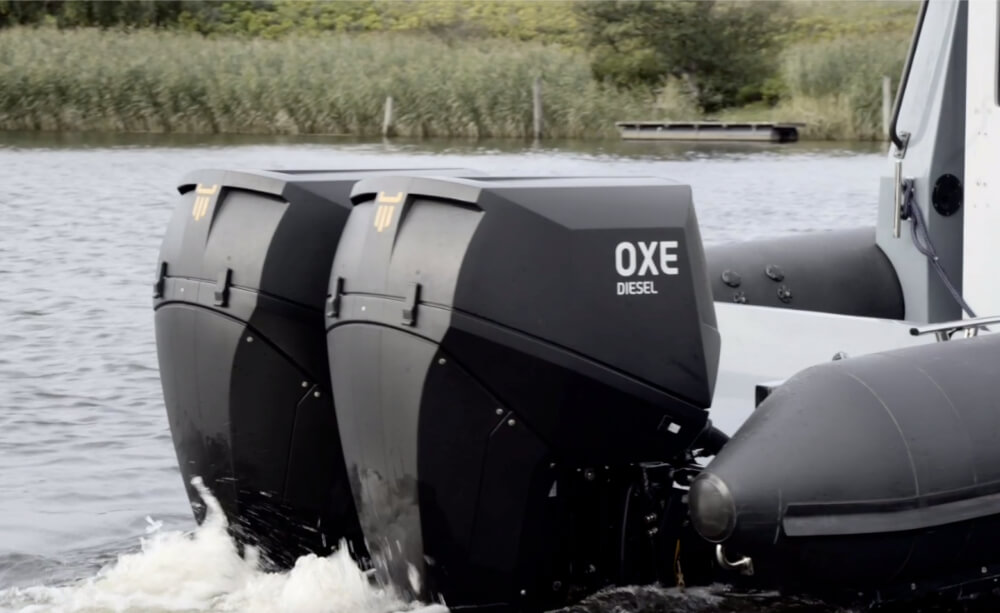
There is no doubt that diesel is by far the safest and most stable fuel one can carry on a boat, particularly in the case of inboards or sterndrives, as there will be no explosive vapours lurking low in the bilge that could be ignited by an errant spark from a battery or shorted starter motor. However, the huge initial cost of the engine – unless it is going to be used commercially over thousands of hours – means that a leisure user will never, ever recoup the cost of purchase. There is certainly the economy factor, with some diesels yielding over 45% thermal efficiency versus about 35% efficiency in a petrol engine (i.e. the diesel engine is almost 30% more efficient), but that characteristic aside, there is little that would compel the leisure boater to spend much (a lot) more money on an engine that will never go anywhere near paying for the difference in price over a petrol engine – not to mention that, in terms of the average 100-hour leisure-boat season, petrol is still one of the cheapest ingredients one can pour into a boat.
There is undoubtedly a market – albeit in a purely commercial context – for the 150-300 hp diesel outboards by OXE of Sweden (and, latterly, Atlanta, Georgia), the CXO 300 by Cox in the UK, and the German-origin 50 hp Neander DTorque 111, but these engines will not be in the vanguard of an alternative fuel wave sweeping the outboard industry. Part of the problem is that there has been a huge consumer push-back on diesel in Europe, with the inordinately stringent (some even say unrealistic) standard of Euro 7 proposed for 2025. These regulations will take the form of vast reductions in the content of carbon monoxide (CO), total hydrocarbons (THC) and nitrogen oxides (NOx). Whilst trucks will have to make a concerted effort to comply with the Euro 7 diesel regulations, car manufacturers like BMW, Mercedes-Benz and Volkswagen realise that the writing is on the wall for diesel automotive engines and that hybrid or electric will be the only realistic avenues to follow.
If and when the lightweight, high-performance diesel engines from Europe cease to exist, there will be no platforms around which high-output diesel outboards could be economically developed.
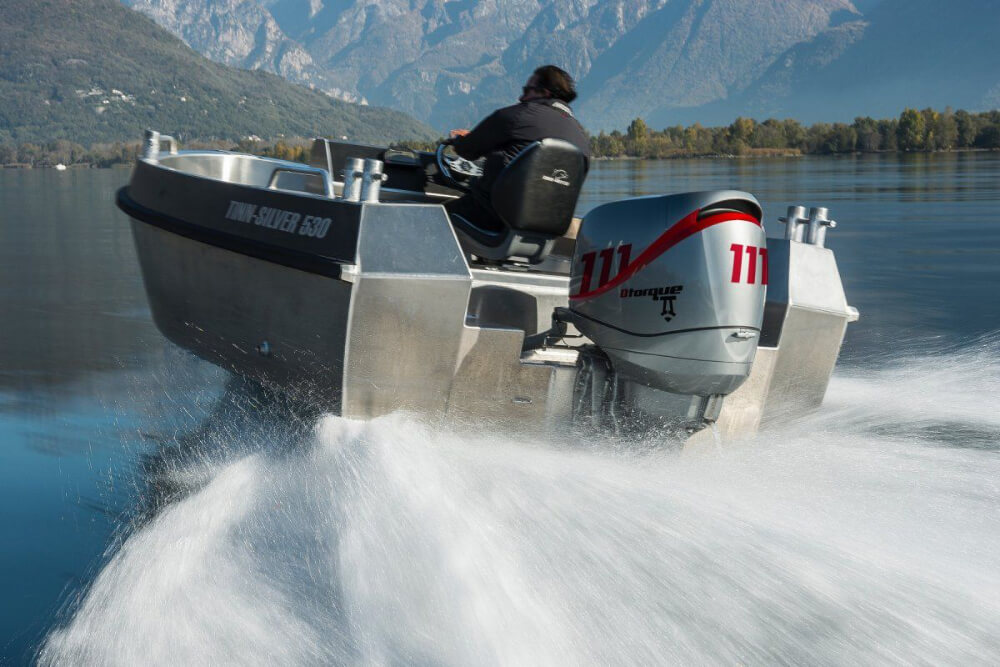
The UK would theoretically have been an ideal market for diesel outboards, as there had always been greatly reduced excise duty on offroad or marine diesel fuel (traditionally dyed red and latterly green), but this status has been rescinded in recent years – so now offroad/marine diesel is the same price as road fuel and there is no cost benefit to running a diesel-powered boat. Ironically, this mandate actually resulted in a substantial increase in the number of high-horsepower petrol outboards being sold in the UK, as many owners of large diesel-engine boats offloaded them once offroad diesel lost
its special excise status, but they still wanted to keep boating and many bought large outboard-powered RIBs instead.
The chances of a mainstream outboard manufacturer committing to a diesel unit are next to non-existent. Yes; Mercury does sell a commercial/military outboard that runs on diesel fuel, but it is a multi-fuel engine that retains spark ignition. Mercury could do a full-on diesel outboard if they so wished, as they supply sterndrive units to Hyundai for the latter’s SeasAll marine diesel range and could theoretically buy the rights to one of the Hyundai power units. I think this unlikely, however. Furthermore, none of the Japanese manufacturers will touch diesel with a bargepole – Honda in particular has never had any affection for the diesel engine and the Japanese do not buy diesel cars.
There is a lot to be said for diesel outboards in NATO, military or police applications, particularly with the NATO policy mandating a single fuel type, and this same premise would apply also to the likes of superyachts (where carrying petrol for on-board toys like RIBs and PWCs has an element of risk) – but the overall adoption and acceptance of diesel outboards will be marginal and specialised. I cannot see how there will ever be enough economies of scale – in terms of volume – to make diesel outboards both affordable and more mainstream. The technology and execution are excellent but will remain the “quirky” preserve of pioneers – like those who bought diesel Peugeots and Benzes when they were curios.
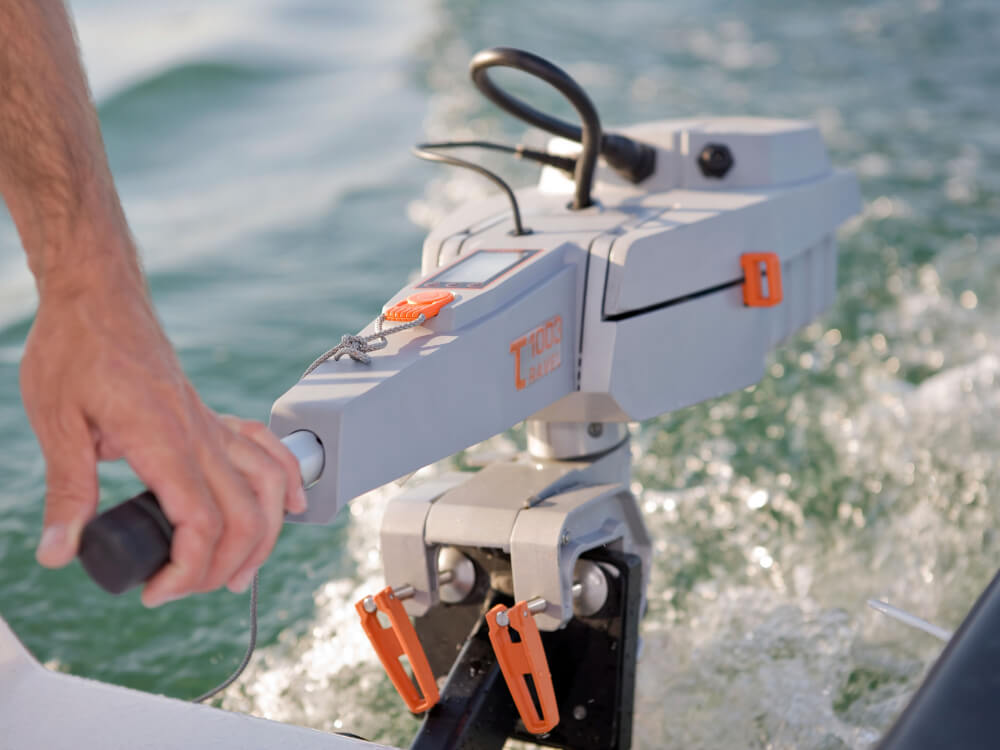
Can Batteries Deliver?
With the headlong rush of automotive manufacturers to embrace electrical motive power, one might think that the future has already been predetermined and mapped out – but this is not so. Whilst I know (or think I know!) a not unreasonable amount about engines of the internal combustion variety, I would be the first to admit that my knowledge of new-technology electric motors and drive systems is, at best, patchy, limited and, at worst, coloured with a fair degree of wary scepticism.
Leaving aside for a moment the huge global footprint and wanton damage to the earth’s surface which will result from the large-scale mining necessary to rip from the ground the precious metals (cobalt, lithium, nickel, manganese, graphite) required to make suitable batteries, it must also be borne in mind that clean air, like clean anything, comes at a price (literally a dollar value). Even the most ardent and fervid pro-EV lobbyists in Europe are now beginning to realise that every EV needs a reliable charger; that every charger needs a reliable and cheap power supply, and that such a power supply can only be generated by power stations. And the best, most effective, most reliable and most economical power stations are all powered by – wait for it – coal!
In what is one of the most ironic dichotomies ever, so committed are the Germans, for example, to EVs, that they have had to recommission at least a dozen coal-fired power stations which had been mothballed – it’s the only way to guarantee a reliable electricity supply. Granted Putin’s antics may have done more than a little to prompt this, but the Germans know that if the supply of electricity stops, then their industries, their daily lives and their EVs will grind to a halt.
Another German company, other than Volkswagen, which has enthusiastically and proactively embraced the potential of electric power is the diesel engine company, Deutz, which has owned Torqeedo, the electric outboard manufacturer, since late 2017. Of all the current and mooted manufacturers of electric outboards, I feel that Torqeedo – due to the financial backing of Deutz and the head-start it has had in the sphere – is probably the one I’d tip for greatest success. I don’t know how practicable or viable a high-output electric motor from Torqeedo or anyone else would be (elaboration on this later), but there is a huge, ready-made, existing market for the mainly portable units currently produced by Torqeedo.

As outlined in a previous article, I feel that Torqeedo will undoubtedly start to capture market share in the light portable 2-15 hp segment – particularly if all that is needed is a motor to push a tender a short distance from a jetty or beach to a large boat. In such a case, electric would be an intelligent,
logical and conscientious choice. If short runs are all an owner envisages, then why bother with filling a fuel tank or opening a fuel tap, then setting a throttle to the “start” position before finally pulling the starting cord? Not to mention that a portable electric outboard can be stored safely in the lazarette of a yacht or launch with no fear of dangerous fuel vapour or spillage. And if one does indeed have the good fortune to be able to drop hundreds of thousands of dollars into a new flybridge cruiser, launch or trawler yacht, and if one wishes to display and propagate an environmental conscience to soothe one’s guilt, then an electric outboard makes a strong statement.
Once Torqeedo starts to attract viable competitors, and the prices of lithium-ion batteries (and the outboards with which they are equipped) eventually correct downward, then there is little doubt that every single one of the major internal-combustion outboard manufacturers will start to see an inexorable encroachment into their portable segment – however, the only way this will ever be known for certain is if/when the importers of electric outboards start to supply their monthly figures to the industry statistics body.
The matter of high-output electric outboards is a different, complex and fraught subject. Such a concept is possible, and has indeed been executed quite well, but all projects so far have involved the purchase of a conventional outboard motor, the discarding of its internal combustion power unit, and the installation of an electric motor in place of the ICE. In August 2022, the American racer, Shaun Torrente, set a world record of 109 MPH in a catamaran powered by two Vision E-Motion electric outboards – which appeared to have been derived from the new 115/140 hp Tohatsu.
But this is where I have to plead ignorance on the whole creation and set-up of boats with lithium-ion power. How big are the batteries? How bulky or heavy are they? Where do the batteries go? Do they go under the floor instead of the fuel tank?
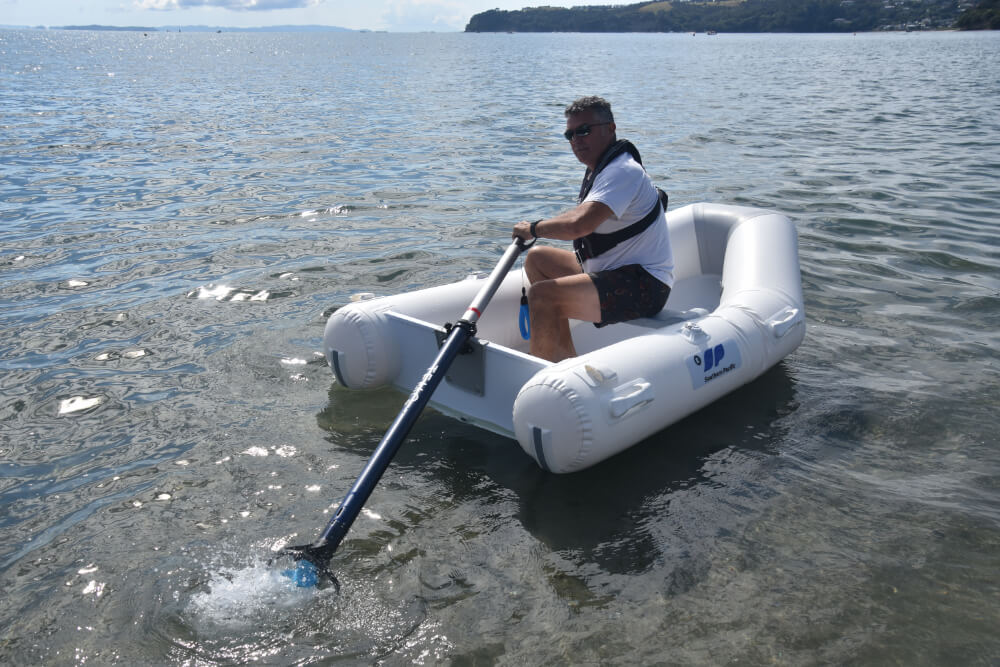
Are they bonded/sandwiched into the floor? Or does the outer case of the batteries actually double as the floor of the boat? Also, in addition to the motive batteries (most likely lithium-ion or a derivative thereof), will the boat still require conventional lead-acid or AGM (Absorbent Glass Mat) batteries to power the electronics, nav lights, bilge pump and radio etc.? If such conventional batteries are still required, how would they be charged?
I would also want my fears addressed on what would happen if the boat started to take on water and sink. Would the occupants receive an electric shock? Would marine life in the water close to the sinking boat receive an electric shock? Would the occupants of any aluminium boats nearby receive an electric shock? Currently too many variables, unknowns and issues of concern, I feel…
I also think that for high-output electric outboards, a large degree of cooperative synergy and shared collaboration will undoubtedly be required between the engine supplier and the boat builder. Such projects would therefore need to be comprehensive, intertwined joint ventures – there is no way a boat can be easily fitted with a large electric outboard in the same way as any ICE outboard can be chosen and conveniently installed. For this reason, I think it’d be a brave boatbuilder who would go all-in with a fledgling, neophyte electric outboard manufacturer to develop a unitary ready-to-go product. In short, then, whilst the portable segment may see some seismic shifts in the not-too-distant future, I can’t see the main players being overly worried about these start-ups offering alternative power sources for high-speed or offshore boating. Weight, incorporation/integration of the boat and motor and offshore “range anxiety” (a heart-palpitating condition familiar to every EV user) should keep the ICE outboard a strong player for many years to come.
Can Hydrogen Help?
In the frenzied clamour towards electrical motive power, one automotive name (the biggest automotive name of all, in fact) is glaringly low-key and maybe even absent – Toyota. Some international automotive pundits and diehard EV proponents have collectively opined that Toyota is dragging its heels, has missed the boat, and will be a follower rather than a leader in the electrification of the automobile. But to that I say one thing: anyone who writes off or dismisses Toyota’s direction
and policies is a fool. Toyota has always been, and remains, the prime advocate for hybrids (i.e. ICE and electric engines in synergy) and the Prius and Camry are sterling examples of its resounding success in this sphere. And whilst Toyota is certainly not against total electrification (and will have no commercial alternative other than to enter the sector), it emphatically believes that the ICE can be cleaned up to the point that it will have no environmental impact at all as it operates.
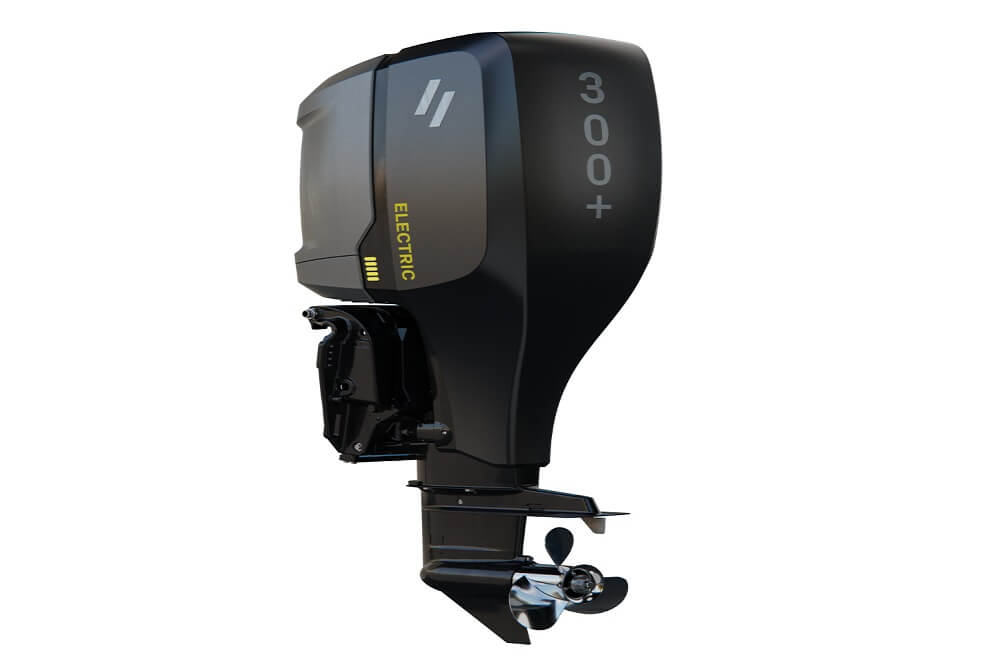
Naturally this cannot be done with relatively dirty fuels like diesel or gasoline, as combustion, no matter how clean or “neutered” the engine, will result in toxic emissions. It could, however, be done with hydrogen and, to this end, Toyota is just one of several manufacturers (Suzuki and Subaru are the other two in Japan and Hyundai/Kia is the main proponent in South Korea) carrying out research on hydrogen fuel cells.
At first glance, hydrogen is an ideal fuel source. It has a high energy content and is extremely clean – emitting only “pure” water from a vehicle’s tailpipe that is theoretically clean enough to drink. Drawbacks, however, are that despite having a high energy content, the energy per unit volume is low in comparison with liquid fuels. Therefore, hydrogen must be greatly compressed and pressurised, and liquefied to such an extent that the tank or reservoir holding the hydrogen has to be much heavier than the weight of hydrogen held therein. This pressurised storage (which can cause leakage), coupled with low-ignition and high-combustion energy, means there is always the imminent risk of a severe explosion (just think of the Hindenburg airship).
Until the issues with the reliable storage and delivery of hydrogen are resolved, it won’t be a mainstream power source in the near future (it will happen sooner or later, though), but as the three Japanese companies – Toyota, Suzuki and Subaru – are reportedly engaged in this research collectively, there will undoubtedly and eventually be a niche for hydrogen-powered vehicles. But as a fuel for outboards? Not as long as I’m alive.
Why Not Stick with What We Have?
As an industry, the outboard motor sector is much, much too small to innovate, develop and see through to fruition alternatively-fuelled or alternatively-powered units. If we take, as just two automotive examples, Subaru and Mazda, these companies are classified as lowish-volume automobile manufactures but still each one produces close to 1.5 million vehicles per annum. To put that into perspective, each of those companies manufactures more units singly than are produced by all manufacturers in the entire outboard industry – the total world market for outboards is just over 850,000 units per annum.
Although currently unlikely, it is not beyond the bounds of possibility that the three Japanese companies who also manufacture automotive engines (Honda, Suzuki and Yamaha) could eventually “trickle down” some EV or hybrid automotive to their outboard lines, but if so, that would not happen until there is a directive for them to so do – after all, why would one unnecessarily and expensively address an issue which one had not yet been asked to address?

The reality is that in terms of damage to the environment, a modern 4-cycle outboard is as efficient, environmentally-friendly and clean as it is possible to be. The “pollution” emitting from outboards is but a drop in the ocean in comparison with the diesel and heavy oil being consumed by, and leaking from, commercial vessels worldwide.
Other than further development and reworking of the current ICE outboard platforms, I can’t honestly see the industry as a whole investing in the creation of completely new models (there is too much international uncertainty in all spheres, for one thing), but I would expect to see current model/derivative gaps in everyone’s ranges plugged and horsepower outputs taken as high as they can go within current platform constraints.
If one were to examine the supposed pollution (noxious and aural) caused by boating, it would pale into insignificance in comparison with what is emitted relatively, scale-wise and percentage-wise, from the likes of chainsaws, whipper-snippers and other power equipment. The outboard industry has progressively and proactively shown the environment enormous respect – it has, after all, virtually
and voluntarily killed the 2-stroke – but I would suggest that it is not beyond the realms of possibility or current technology to further “clean up” all existing 4-strokes a little should such a change ever be mandated.
It could possibly be that, lurking around the corner, there is a wholly revolutionary, ruthlessly efficient, environmentally-friendly and viable product that will create an entirely new standard and genre but it’d take some doing to better the integrity and environmental empathy built into what we are using today. I can honestly say, therefore, that I can see no reason why my kids will not be able to confidently, enthusiastically and conscionably purchase an ICE outboard motor to pursue their own boating dreams.


